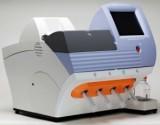Welcome to the third OSUCCC Shared Resources Quarterly Newsletter. Our goal is to provide you with important updates on our shared resources, such as new equipment and capabilities, to highlight the excellent science resulting from each shared resource, such as new equipment and capabilities, to highlight the excellent science resulting from each shared resource, and to keep you updated on how we provide these services. We appreciate your feedback. Email Veronica Rice at Veronica.Rice@osumc.edu.

Medicinal Chemistry Shared Resource
The The Center for Clinical and Translational Science (CCTS) is pleased to announce a new matching fund program to assist members in obtaining custom syntheses of small molecules not otherwise available. The purpose of the program is to promote the use of these new compounds in translational research projects. This program is part of the Drug Discovery and Development Core of the CCTS and is offered in conjunction with the Medicinal Chemistry Shared Resource (MCSR) of the OSU Comprehensive Cancer Center.
Interested investigators should contact the MCSR to discuss their needs and the resources ability to synthesize their compounds of interest. Following consultation, investigators can request a quote from the MCSR to provide the compounds. Investigators should then submit an application to the CCTS for matching funds for the project. The CCTS will match up to 50 percent of the cost of synthetic preparations up to a $5000 maximum on projects receiving approval. The awardee will be required to acknowledge the CCTS in any publications resulting from the use of these matching funds.
For more information, contact Dr. Michael Darby at darby.1@osu.edu.

Biostatistics
The OSU Center for Biostatistics welcomes Dr. Joseph P. McElroy, a biostatistical scientist with more than 10 years experience in large-scale, genome-wide studies and high-dimensional data analysis. Originally from Ohio, Dr. McElroy obtained his PhD from Iowa State University in Genetics in 2005, followed by a postdoctoral position at the University of California, San Francisco, studying the genetics of multiple sclerosis (2005-2011). Dr. McElroy specializes in SNP, CNV and microarray analyses, and is currently turning his talents to sequence analysis (DNA, RNA, Meth and Chip). McElroy also is a postdoctoral fellow working with Dr. Gustavo Leone, Dr. Michael Ostrowski and Dr. Soledad Fernandez.
Pharmacoanalytical Shared Resource (PhASR)
PhASR releases exciting new finding of an important old drug
Members of the Experimental Therapeutics Program have discovered that the decades-old drug 5-azacytidine, recently approved for treatment of myelodysplastic syndrome (MDS) by the US Food and Drug Administration, strongly inhibits ribonucleotide reductase as a major mechanism of action. This finding provides strong evidence for its RNA effect and now helps clarify its distinction from a close member decitabine, another drug approved for MDS. The surprise finding is in its self-limitation of reduction to decitabine, which is the major reason for the DNA hypomethylation activity. This finding published in the journal Blood in April (“RNA-dependent inhibition of ribonucleotide reductase is a major pathway for 5-azacytidine in acute myeloid leukemia.” Joseph Aimiuwu, Hongyan Wang, Ping Chen, Zhiliang Xie, Jiang Wang, Shujun Liu, Rebecca Klisovic, Alice Mims, William Blum, Guido Marcucci, and Kenneth Chan. April 19, 2010; doi:10.1182/blood-2011-11-38226). Based in part of this information, a phase-I clinical trial, entitled “A Phase 1 study of azacitidine in combination with MEC (mitoxantrone, etoposide, cytarabine) in relapsed and refractory acute myeloid leukemia,” is being carried out under the UO1 program at the Arthur G. James Cancer Hospital and Richard J. Solove Research Institute.
Biomedical Informatics Shared Resource (BISR)
Dr. Kun Huang, of the BISR was awarded a Department of Energy KBase Phase I SBIR grant, in collaboration with KitWare Inc., for developing a cloud computing-based, next-generation sequencing data-management system. Terry Camerlengo in BISR will also participate in this project.
GENOMICS
Nucleic Acid Shared Resource (NASR)
 The Nucleic Acid Shared Resource now has an ionTorrent. Powered by Ion Torrent™ semiconductor chip technology, the Ion Personal Genome Machine™ (PGM™) Sequencer delivers the fastest run times, at the most affordable price, of any next-generation sequencer. High accuracy and long reads put the Ion PGM™ Sequencer in a class of its own and makes next-generation sequencing more accessible to scientists around the world. Come try our affordable bench-top sequencer for small genomes and targeted sequencing. For more information, contact Dr. Alder at Hansjuerg.Alder@osumc.edu or visit go.osu.edu/NASR The Nucleic Acid Shared Resource now has an ionTorrent. Powered by Ion Torrent™ semiconductor chip technology, the Ion Personal Genome Machine™ (PGM™) Sequencer delivers the fastest run times, at the most affordable price, of any next-generation sequencer. High accuracy and long reads put the Ion PGM™ Sequencer in a class of its own and makes next-generation sequencing more accessible to scientists around the world. Come try our affordable bench-top sequencer for small genomes and targeted sequencing. For more information, contact Dr. Alder at Hansjuerg.Alder@osumc.edu or visit go.osu.edu/NASR
Microarray Shared Resource (MASR) Agilent’s Comprehensive Cancer Center FREE Tour and Seminar on June 5, in the Biomedical Research Tower. Click here to download a flier to print and post. Lunch provided. Register at www.agilent.com/genomics/ccc
OTHER NEWS
eRAMP – eramp.osumc.edu is now live. Use this as a portal to obtain services to OSUCCC Shared Resources. Additional cores will be added soon.
Current and past Shared Resources Quarterly Newsletters availalbe online.

|